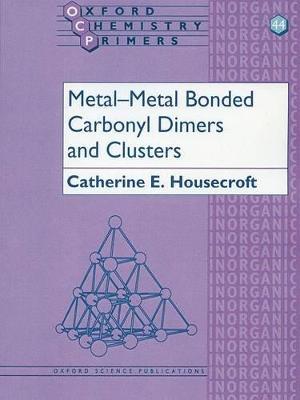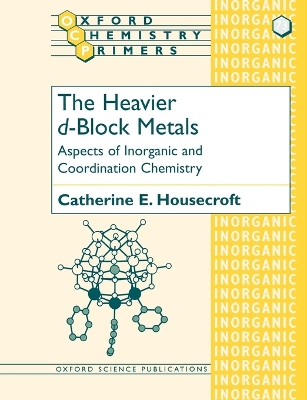Oxford Chemistry Primers
3 primary works
Book 14
This new addition to "Oxford Chemistry Primers" series provides a comprehensive survey of the structures, bonding, synthesis, and reactivity of the title molecules and includes clusters found in the elemental state as well as compounds. It includes fullerenes C(60). Also presented is a balanced introduction to the chemistry and structures of boranes, heterboranes, cubanes, adamantane-type clusters, Zintl ion, donor-acceptor clusters, and others. Terms commonly encountered in cluster chemistry are defined and polyhedral frameworks are described.
Book 44
The potential commercial uses of some compounds as catalysts has generated much research interest. Metal-metal bonded dimers and clusters are an example of these. This concise basic approach to the subject covers among other topics: structure of metal-metal bonded dimers and clusters including both small and large clusters, synthesis of reprensentative dimers and clusters, and localized bonding schemes and their limitations. Highly illustrated, with a relatively basic text that includes problems, this addition to the Oxford Chemistry Primers series will be valuable to the advanced chemistry undergraduate.
Book 73
This book addresses the chemistry of the second and third row d-block metals, assuming a knowledge of the chemistry of the first row metals.
Chapter 1 looks at the metals and summarizes occurrence, physical properties and uses.
Chapter 2 considers periodic trends in properties.
Chapter 3 considers aqueous solution chemistry, species present (with comparisons of the first row metal ions) and redox properties.
Chapter 4 surveys structure: the range of coordination numbers shown by second and third row metals is often a topic for discussion in University courses.
Chapter 5 looks at electronic spectra and magnetic properties, making comparisons with the first row the main objective of the chapter. Detailed mathematical treatments are not given.
Chapter 6 considers metal-metal bonding, and the classes of compound that contain triple and quadruple bonds; the role of bridging ligands is introduced.
Chapter 7 looks at selected clusters with a pi donar ligands (e.g. metal halo species) in which metal-metal bonding is important.
Chapter 8 introduces the area of polyoxometallates, closing with a short discussion of the wide range of applications.
The book contains many references to encourage wider reading by the student; in addition to textbooks of relevance, the author has included many recent literature citations, and a section called "Metals in Action" which gives citations which show the heavier metals at work in, for example, catalytic converters and molecular wires.
Chapter 1 looks at the metals and summarizes occurrence, physical properties and uses.
Chapter 2 considers periodic trends in properties.
Chapter 3 considers aqueous solution chemistry, species present (with comparisons of the first row metal ions) and redox properties.
Chapter 4 surveys structure: the range of coordination numbers shown by second and third row metals is often a topic for discussion in University courses.
Chapter 5 looks at electronic spectra and magnetic properties, making comparisons with the first row the main objective of the chapter. Detailed mathematical treatments are not given.
Chapter 6 considers metal-metal bonding, and the classes of compound that contain triple and quadruple bonds; the role of bridging ligands is introduced.
Chapter 7 looks at selected clusters with a pi donar ligands (e.g. metal halo species) in which metal-metal bonding is important.
Chapter 8 introduces the area of polyoxometallates, closing with a short discussion of the wide range of applications.
The book contains many references to encourage wider reading by the student; in addition to textbooks of relevance, the author has included many recent literature citations, and a section called "Metals in Action" which gives citations which show the heavier metals at work in, for example, catalytic converters and molecular wires.


